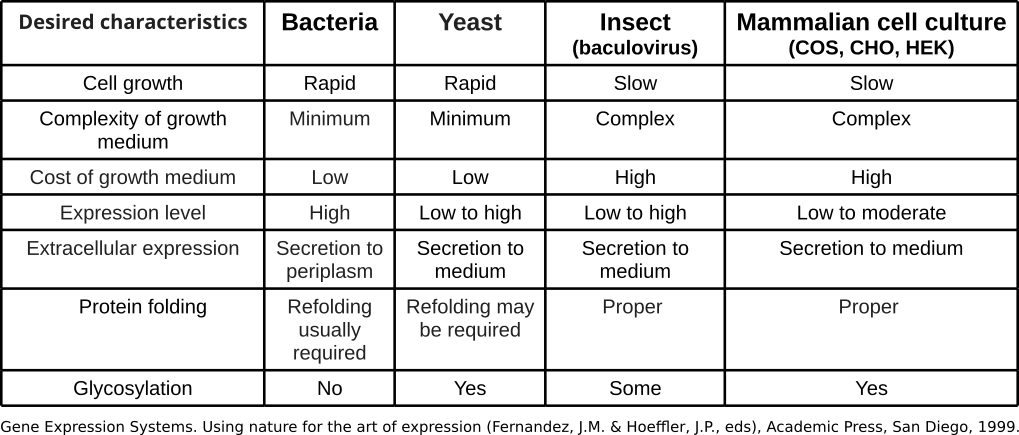Contents
Protein Expression
Recombinant DNA technology has many uses in basic scientific research to better understand the nature of of living things. As a tool, recombinant DNA technology can be used to express proteins towards medical applications. Prior to biotechnology, type I diabetes (insulin-dependent) was treated by injection of insulin isolated from the pancreas of pigs. With the ability to express human proteins inside bacteria, yeast and other cells, sacrificing pigs for porcine insulin is no longer necessary.

 Bacteria or other cells can be engineered to express proteins through the process of cloning and transformation. Bacteria are advantageous because of their rapid life cycle and ease of growth. A bacterial expression vector contains the basic plasmid features: origin of replication as well as antibiotic resistance gene. Often, an affinity tag will be used to aid in purification of the protein. An example in the vector above shows the GST (glutathione-s-transferase) tag that can be purified with glutathione resin. Expression is only the first problem since bacteria are also synthesizing proteins that are required for the bacteria to grow and divide. Injecting these proteins in addition to insulin would cause an immune reaction that could be deadly. Therefore, it is required that overexpressed proteins be purified and isolated from other undesirable proteins.
Bacteria or other cells can be engineered to express proteins through the process of cloning and transformation. Bacteria are advantageous because of their rapid life cycle and ease of growth. A bacterial expression vector contains the basic plasmid features: origin of replication as well as antibiotic resistance gene. Often, an affinity tag will be used to aid in purification of the protein. An example in the vector above shows the GST (glutathione-s-transferase) tag that can be purified with glutathione resin. Expression is only the first problem since bacteria are also synthesizing proteins that are required for the bacteria to grow and divide. Injecting these proteins in addition to insulin would cause an immune reaction that could be deadly. Therefore, it is required that overexpressed proteins be purified and isolated from other undesirable proteins.
Criteria for Choosing an Expression System

Protein expression systems have inherent advantages and disadvantages. The table above summarizes the comparison of the various cellular systems of production (Fernandez & Hoeffler, 1999).

Purification
Different methods of isolation can be applied depending on the properties of the protein. Ion exchange chromatography is useful if the protein of interest has a specific charge that will interact with a resin packed with the opposite charge.

Immunoprecipitation

Affinity Purification
Affinity purification employs the use of specific antibodies that bind to the protein of interest very tightly to retain it on a column. With these techniques, the protein retained on the resin is washed numerous times to remove other proteins that are non-specifically sticking. A change in pH or ionic conditions then is used to disrupt the interaction with the resin and elute the proteins from the column. Proteins that are engineered to contain tags can be purified by antibodies specific to those tags. Also, the addition of 6 or more consecutive Histidine residues to the end of a protein make them susceptible to purification with Nickel-NTA resin or Cobalt purification. In these cases, the 6XHis tag associates with these metal ions on the resin and are selectively adhered.

Size Exclusion
Most of you are familiar with water purification filters. Before using these filters, you soak them in water and dark residue leaks out. This dark residue is activated charcoal. The activated charcoal has tiny microscopic pores that trap small items like ions and other particles. The primary goal of these filters is to remove metals and chlorine that are found in tap water. The porous nature of activated charcoal renders it useful for trapping molecules in water purification systems .
 The process used to trap these small particles is called size exclusion. Unlike agarose gel electrophoresis where the smaller particles navigate through the matrix faster, size exclusion resins trap the smaller molecules.
The process used to trap these small particles is called size exclusion. Unlike agarose gel electrophoresis where the smaller particles navigate through the matrix faster, size exclusion resins trap the smaller molecules.

The smaller the molecule, the longer they spend within the pores as they traverse through the matrix.

Significance of Purification
All injectible drugs must be clean of endotoxins from bacteria. Purification of the protein of interest from bacterial lysates removes the dangerous pathogenic materials from that would otherwise activate host immune reactivity.
The horseshoe crab (Limulus polyphemus) performs a special function in the ecosystem by providing eggs for migratory birds to feed on. This organism also houses a special cell type in its hemolymph. The limulus amoebocyte lysate (LAL) test is the most sensitive assay of detecting endotoxins from bacteria. Amoebocytes are collected from these organisms for use on testing batches of injectible drugs to ensure proper purification and safety.
References
- Joseph M. Fernandez and James P. Hoeffler. Introduction: SO MANY POSSIBILITIES: HOW TO CHOOSE A SYSTEM TO ACHIEVE YOUR SPECIFIC GOAL, In Gene Expression Systems. Academic Press, San Diego. 1999, Pages 1-5, ISBN 9780122538407. http://dx.doi.org/10.1016/B978-012253840-7/50001-8.
Tags: applied knowledge, life-long learning, analysis, integration of knowledge


